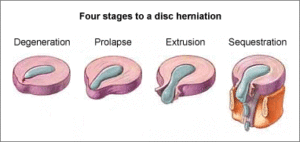There are actually four types of disc herniations. Each one can present with different symptoms and treatment can vary.
- Disc Bulge– In the picture below it’s labelled degeneration. This is a broad pushing out of the disc. Sometimes this can put pressure along the spinal cord. Typically it has thinning of the disc. Most patients present with chronic aching pain in their back/neck.
- Disc Prolapse– This can also be called a protrusion. They differ slightly in whether the disc bulges more posterior or is wider laterally. This type of herniation can push on the spinal cord or the exiting nerve root. Pain can be chronic like a bulge and can radiate down an arm or leg.
- Disc Extrusion– Getting into more severe causes now. The annular fibers that make up the wall of the disc have ruptured with this one. This allows the nuclear material (is a jelly like substance) inside the disc to push out. This also can push on the spinal cord and nerve roots. Typically causing the same symptoms as a prolapse.
- Disc Sequestration– The granddaddy of them all. This one has complete rupture of the annular fibers. The nuclear material has squeezed out of the disc and has extended beyond the disc. They usually run down, we call it caudal, the spine. This one along with pain can cause neurological problems. Such as weakness, atrophy, foot drop, cauda equina syndrome, etc. Cauda euina is the inability to control your bowel or bladder and is a medical emergency. It’s rare, as in I’ve seen about 5 in my 15 years of practice.
What can you do to fix it?
The good news is neurosurgeons have started taking a more conservative approach with the first three classifications. If there isn’t a neurological deficit (muscle atrophy, inability to move a body part, complete numbness) they usually like to do physical therapy, pain injections, accupuncture, home exercising and of course CHIROPRACTIC!!
Yes you can be adjusted when you have a disc herniation. In fact you should be adjusted. Using a flexion technique a chiropractor can create a vacuum that helps pull the disc back into place. The technique is very gentle.
The bad news?
It can take as much as 2 years for a disc to completely heal. Yep you read that right. The disc is a ligament so it doesn’t have a direct blood supply. It gets all its nutrients from the bone that it is attached to. Much like if you drop your fork at the restaurant, you have to wait for your server to bring you a new one. It takes longer to get that food in your mouth 🙂
Your pain will not be as severe as in the acute phase, but you are more likely to re-injure the disc.
How long until you feel better?
Most disc patients start to feel like they have more of an aching tightness in their back after about 6 months under chiropractic care. Home exercising should be done to strengthen the core and spine. PT can be helpful, especially if you are not somebody that normally exercises and need some guidance. Pain injections can be helpful to control the pain level. Also makes it easier to get adjusted if you have less pain.
Chiropractors specialize in all disorders of the spine, and this includes disc herniations. Dr. Myers has been serving Southwest Michigan since 2002. Give us a call and find out how chiropractic care can help you.

4 Types of Disc Herniations
